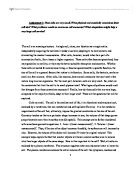Cells are small. The cell is the smallest unit of life; it is a functional and structural unit, enclosed by a membrane, that can metabolize and self-replicate (Tortora). It is the metabolic requirements of the cell that, ultimately, impose the greatest constraints on the size of the cell. Geometry teaches us that as a particular shape increases in size, the volume of that shape grows proportionately more than its surface area (Campbell). This concept can be further elucidated with some basic geometric equations: 1. Area = (linear measurement)2, 2. Volume = (linear measurement)3. Thus, if the size of an object increases threefold, its surface area will increase by nine. However, the volume of the object will increase 27 times the original volume! This example helps explain the fact that smaller objects will have a smaller surface area to volume ratio than larger objects of the same shape. How is this important to the cell? Well, all cells are enclosed by a plasma membrane. This structure regulates what can and cannot enter or leave the cell. The plasma membrane encloses the entire volume of the cell: the cytoplasm, nucleus and other organelles. Within the cell, many metabolic reactions occur which are required to keep the cell healthy and functional. Most cells require oxygen and other nutrients for cellular respiration to occur, and these cells must be able to excrete waste products, like carbon dioxide, as well as other molecular products that it may produce (e.g. insulin is secreted by some cells of the pancreas, and thyroxine is produced by cells of the thyroid gland). For each square micrometer of the plasma membrane that surrounds the cell, there is a limit to the amount of waste or biological product that can cross its protective barrier (Campbell). Thus, the surface area of the cell (i.e. its plasma membrane) must be able to accommodate all of the metabolic reactions that occur within its interior. Although a large cell would be able to withstand more metabolic reactions (due to its larger volume) than a smaller cell, the larger cell would have much less plasma membrane than the smaller cell to allow for the proper excretion of its metabolic products. This “larger cell” would essentially be unable to excrete all of its waste and other products creating a toxic buildup of these chemicals in its cytoplasm. Thus, most cells are small due to metabolic restraints.
So, how do large cells, like neurons, bypass these constraints and still function properly? Well, large cells, like neurons, have made special adaptations that allow for their larger size. First, large cells often have many cell processes that help increase the surface area of the cell relative to its volume. In the case of neurons, long cylindrical processes like dendrites and axons extend from the central (and bulkier) cell body of this cell. These processes are responsible for carrying biological products like neurotransmitters down their length. Most of the metabolic reactions occur in the cell body, leaving the cell processes (e.g. axons) to focus on the transport of the products of these reactions. In the case of neurons, the neurotransmitters are produced in the cell body, they are then carried down the axon by axonal transport, then they reach the end of the axon where they can be released at the synapse to transmit the neuronal signal to the next cell. Other large cells may adapt by creating folds or involutions along their plasma membrane. Any structural adaptation that will allow the cell to increase its surface area without drastically increasing its volume will allow cells to grow in size without compromising its health and general function.
Some organisms can grow to be very large because they are made of very many cells, each programmed for a specific function that allows the organism to function properly. However, the smallest unit of life, the cell, is limited in its size. If there is a lesson to be learned from the cell, it is this: only working with others can we grow to become larger than we are alone.
Bibliography
Tortura and Grabowski 2003 Principles of Anatomy and Physiology pg. 59
Campbell 1990 Biology, 2nd edition pg. 123







